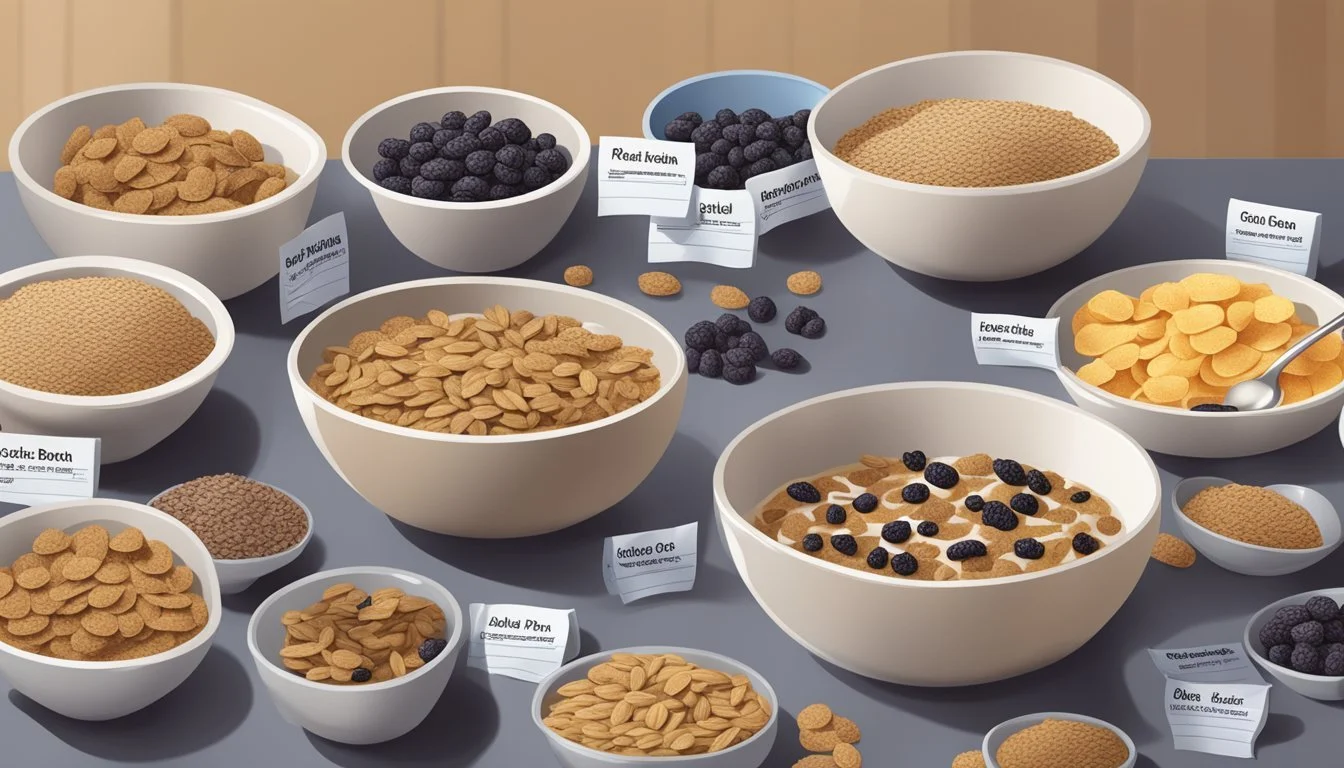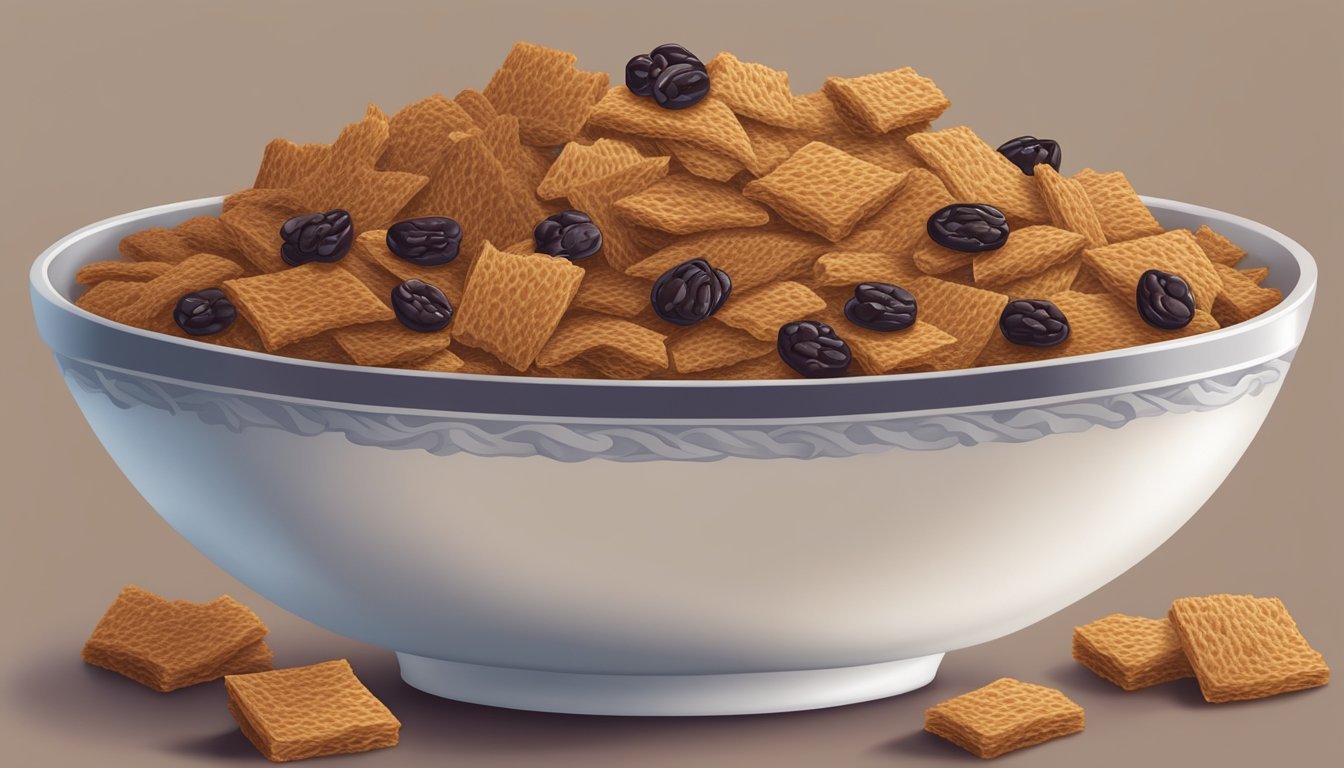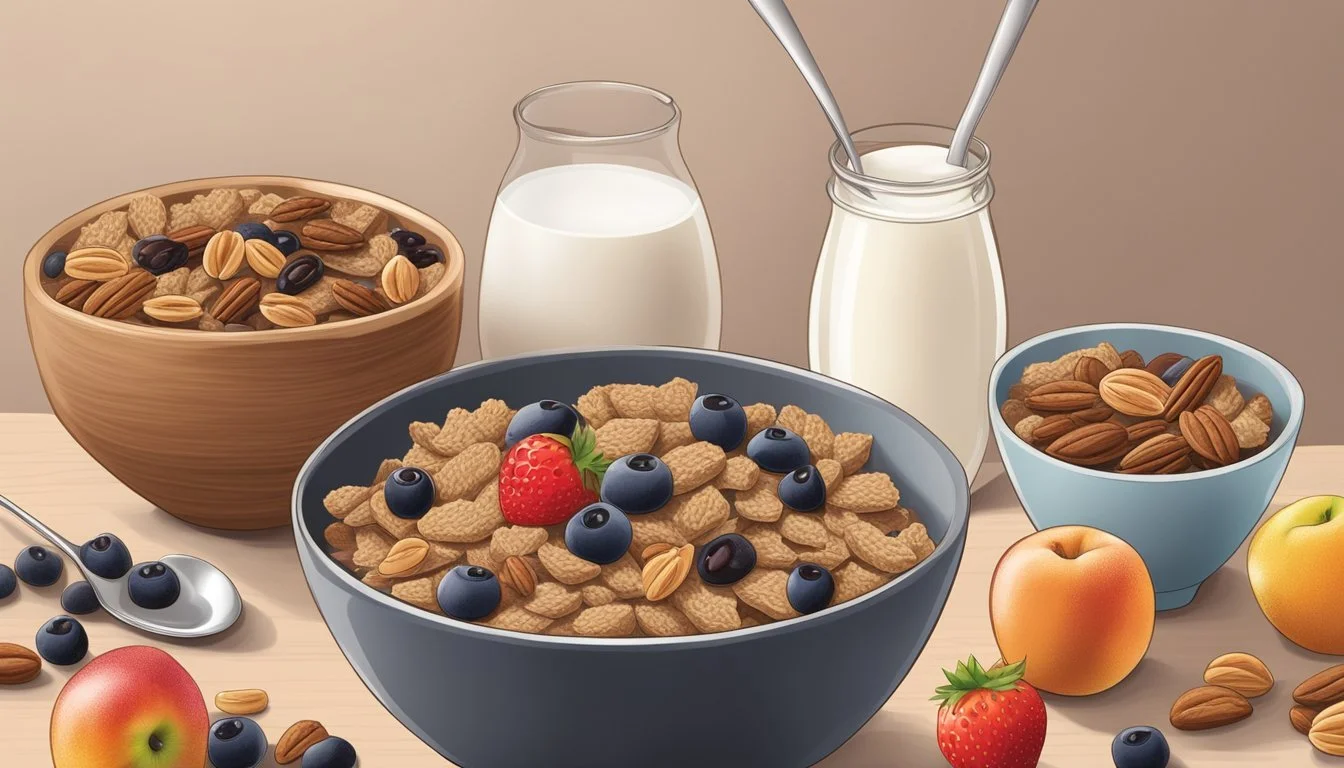All-Bran vs Post Raisin Bran Cereal
A Nutritional Comparison
This Article is Part of Our Breakfast Cereal Guide with Details on All-Bran Nutrition and Post Raisin Bran Cereal Nutrition
Choosing between All-Bran and Post Raisin Bran can be a challenge for cereal enthusiasts looking to start their day with a nutritious meal. Each of these cereals caters to different nutritional needs and preferences, making it essential to compare them based on key aspects such as calorie content, carbohydrate levels, and fiber.
All-Bran stands out for its lower calorie count and higher fiber content, making it a superior choice for those aiming to increase their daily fiber intake and manage their weight effectively. On the other hand, Post Raisin Bran offers a slightly higher carbohydrate content and a sweeter taste, which might appeal to individuals who prioritize flavor in their breakfast routine.
This blog post will dissect these cereals' nutritional profiles, helping you decide which one aligns best with your dietary goals. Both have their merits, but your choice will ultimately depend on your specific health objectives and taste preferences.
Cereal Comparison Overview
All-Bran and Post Raisin Bran are widely known bran cereals that cater to health-conscious consumers. They differ in their historical backgrounds, nutritional compositions, and types of varieties offered.
Brand Histories and Profiles
All-Bran: Manufactured by Kellogg's, All-Bran has been a prominent name in the breakfast cereal market for decades. Introduced in 1916, this cereal is notable for its high fiber content. Kellogg’s emphasizes gut health, positioning All-Bran as a beneficial choice for digestion support.
Post Raisin Bran: Post Consumer Brands introduced Raisin Bran in 1942. Initially developed by U.S. Mills, it later joined Post's product line. Known for its combination of wheat bran flakes and raisins, Post Raisin Bran has maintained a reputation for being a nutritious breakfast staple.
Cereal Types and Varieties
All-Bran: Generally available in various forms, including the classic All-Bran Original and All-Bran Buds. Each variant is designed to meet different dietary preferences.
Nutritional Highlights:
Fiber: Approximately 10g per serving
Protein: About 3g per serving
Calories: Roughly 70 calories per 0.33 cup serving
Post Raisin Bran: Combines wheat bran flakes with raisins, offered as a single main variant differing mainly by package sizes.
Nutritional Highlights:
Fiber: Around 7g per serving
Protein: About 5g per serving
Calories: Roughly 120 calories per 0.67 cup serving
These cereals provide essential nutrients, making them suitable for a balanced diet.
Nutritional Content Analysis
All-Bran and Post Raisin Bran cereals offer distinct nutritional profiles, making each suitable for different dietary needs. This section breaks down pertinent nutritional factors including fiber, proteins, carbohydrates, vitamins, minerals, calories, and sugars.
Fiber Content
All-Bran is known for its high fiber content, delivering 9.0 grams of dietary fiber per serving. Fiber aids in digestion, helping maintain a healthy gut.
Post Raisin Bran, on the other hand, provides 6.0 grams of dietary fiber per serving. Though lower, it still offers a significant portion of the daily fiber intake for many.
For those focused on maximizing fiber intake, All-Bran takes the lead.
Protein and Carbohydrates
Proteins and carbohydrates play crucial roles in overall health. Both cereals contain notable amounts of these macronutrients.
All-Bran has 7.0 grams of complex carbohydrates per serving. Complex carbs are beneficial for sustained energy. Post Raisin Bran contains 11.0 grams of complex carbohydrates, indicating a higher energy potential.
Regarding protein, detailed comparative data is not provided in the search results, but both cereals contribute to daily protein needs.
Vitamins and Minerals
Vitamins and minerals are essential for various bodily functions. All-Bran significantly excels in providing B vitamins. It also offers substantial iron content, aiding in oxygen transport within the body.
Post Raisin Bran contains 7 times less Vitamin B12 than Bran cereal. However, it still offers valuable vitamins and minerals such as calcium, zinc, and potassium, which support bone health and metabolic functions.
Calories and Serving Sizes
Calories are a fundamental aspect of any dietary plan.
All-Bran contains 190 calories per serving, making it suitable for calorie-conscious consumers. Post Raisin Bran also has 190 calories per serving, providing an equivalent caloric value.
Serving sizes for both cereals are relatively standardized, ensuring easy comparison and dietary planning.
Sugars and Added Sugars
Sugars, particularly added sugars, are an important consideration. High sugar intake can lead to various health issues.
All-Bran has negligible amounts of added sugars, making it ideal for those monitoring their sugar intake. Post Raisin Bran, while higher in natural sugars due to added raisins, should still be considered cautiously for those restricting sugars.
The lower added sugar content in All-Bran makes it a preferred choice for sugar-conscious diets.
Health Benefits and Considerations
Both All-Bran and Post Raisin Bran cereals offer notable health benefits but also have aspects to consider for maintaining a balanced and healthy diet. Each cereal provides a good source of dietary fiber, essential nutrients, and supports various aspects of health.
Whole Grains and Digestive Health
Whole grains are a significant component in both All-Bran and Post Raisin Bran cereals. They provide considerable amounts of fiber which are crucial for digestive health. Bran, the hard outer layer of grains, is rich in insoluble fiber that promotes bowel regularity and can help prevent constipation.
All-Bran, in particular, offers 7 grams of fiber per serving. This high-fiber content aids in maintaining digestive health and supporting a healthy gut microbiome. For those aiming to improve their digestive health through dietary choices, both cereals can be beneficial.
Balanced Breakfast and Weight Management
Including cereals like All-Bran and Post Raisin Bran as part of a balanced breakfast can help with weight management. High-fiber foods tend to be more filling, which can reduce overall calorie intake by promoting satiety.
All-Bran has fewer calories per serving compared to Post Raisin Bran, making it a potentially better option for those monitoring their caloric intake. However, both cereals provide complex carbohydrates and essential nutrients that contribute to a healthy breakfast, supporting long-term weight management goals.
Heart Health and Dietary Fiber
Dietary fiber, particularly soluble fiber, is beneficial for heart health. It helps lower cholesterol levels and supports a heart-healthy diet. Both All-Bran and Post Raisin Bran contain significant amounts of fiber, although the type and amount may vary.
All-Bran is often highlighted for its role in promoting heart health due to its higher fiber content. Consuming the recommended daily intake of fiber (25 grams for women and 38 grams for men) can reduce the risk of heart disease. Both cereals, incorporated into a balanced diet, contribute to meeting these dietary recommendations.
Sugar Intake and Healthy Choices
A point of consideration is the sugar content in these cereals. Post Raisin Bran contains 14 grams of sugar per serving, with approximately 9.5 grams being added sugar. This is important for those monitoring their sugar intake or managing conditions like diabetes.
All-Bran, with its lower sugar content, might be a healthier choice in this regard. Opting for cereals with minimal added sugars is essential for maintaining a healthy diet. When making healthy choices, it’s important to balance the nutritional benefits of high-fiber cereals with their sugar content.
Taste and Texture Profile
This section explores the taste and texture differences between All-Bran and Post Raisin Bran cereals, focusing on the sweetness of raisins and the crunchiness of cereal grains, along with various ingredient combinations.
Raisins and Sweetness Variants
Raisins in Post Raisin Bran are often noted for their sugar coating. This additional sweetness complements the earthy bran flakes, creating a balanced flavor profile.
All-Bran, meanwhile, lacks the raisin component, resulting in a plainer, more straightforward taste. The absence of raisins means All-Bran depends more on its bran taste and added ingredients like honey or dried fruit for sweetness.
Cereal Grains and Crunchiness
Post Raisin Bran features large, thin, and flat flakes. While initially crisp, these flakes can lose their crunch quickly when soaked in milk. The texture shifts from crispy to slightly softer but maintains a chewiness due to the raisins.
All-Bran, composed of denser bran flakes or sticks, retains much of its crunchiness. This cereal stays firmer in milk, providing a consistent texture.
Ingredient Combinations
Post Raisin Bran includes sugar-coated raisins, adding bursts of sweetness. Some variations might include additional ingredients like nuts or seeds, enhancing both flavor and texture diversity.
All-Bran may incorporate elements such as granola clusters or a hint of honey. These additions not only boost the flavor profile but also improve the overall texture, offering crunchiness beyond that of the bran flakes alone.
Environmental and Dietary Concerns
Both All-Bran and Post Raisin Bran cereals have distinct qualities in terms of organic ingredients and sustainability, as well as options for those looking to avoid GMOs and added sugars.
Organic Ingredients and Sustainability
When considering environmentally friendly options, the use of organic ingredients is essential. Organic farming practices reduce the reliance on synthetic pesticides and fertilizers, which can be harmful to the environment. As of 2024, neither All-Bran nor Post Raisin Bran are explicitly marketed as being organic.
Sustainability also involves packaging and production processes. Look for brands that emphasize recyclable packaging and sustainable sourcing of ingredients. Such measures significantly reduce environmental impact. Brands focusing on sustainability often highlight these practices on their packaging or websites.
Non-GMO and No Added Sugar Options
For dietary concerns, consumers may look for non-GMO ingredients and cereals with no added sugar. Non-GMO ingredients ensure that crops are not genetically modified, appealing to those concerned about genetic engineering. As of the latest data, Post Raisin Bran and All-Bran do not specifically label their products as non-GMO.
Additionally, reducing sugar intake is a priority for many. All-Bran does not specifically have a no added sugar variant, containing minimal sugars compared to Raisin Bran. Post Raisin Bran typically contains added sugars due to the raisins and additional sweeteners. Consumers should always check the nutritional information to ensure they are selecting cereals that align with their dietary preferences.
Market Presence and Consumer Information
When comparing All-Bran and Post Raisin Bran cereals, key factors include pricing, brand loyalty, and consumer ratings. Each of these elements provides insight into how these cereals are perceived and consumed in the market.
Pricing and Economic Factors
All-Bran and Post Raisin Bran have varied pricing influenced by factors such as ingredient costs and brand positioning. All-Bran typically costs around $4.50 per box. Post Raisin Bran, known for its Sun-Maid® raisins, averages about $4.00 per box.
Although both cereals are competitively priced, promotional discounts and bulk purchasing options can affect consumer choice. The economic factor of fiber and nutrient value per dollar also plays a critical role in consumer decisions, especially in budget-conscious households.
Manufacturer and Brand Loyalty
Kellogg's manufactures All-Bran, while Post Consumer Brands produces Post Raisin Bran. Both companies are established players in the cereal market, boasting strong brand loyalty among consumers.
Kellogg's leverages its historical reputation and innovative marketing strategies to foster loyalty. Post, on the other hand, emphasizes natural ingredients like Sun-Maid® raisins, aligning with health-conscious consumers. Brand differentiation through packaging, advertising, and ingredient quality contributes significantly to consumer preference.
Consumer Ratings and Preferences
Consumer ratings highlight the satisfaction levels and preferences for each cereal. All-Bran receives high praise for its high fiber content, appealing to health-focused buyers. Consumer reports rate it 4.5 out of 5 stars, endorsing its nutritional benefits and taste.
Post Raisin Bran is appreciated for its sweetness and use of real raisins, earning it a solid 4.0 out of 5 stars. Preferences often depend on taste, dietary needs, and brand familiarity.
Raisin bran's popularity has shifted by 20.17% over the past year. On average, it's consumed 1.14 times per year. Market adoption in restaurants remains low.
Serving Suggestions and Variations
Experimenting with serving sizes and mix-ins can transform a simple bowl of All-Bran or Post Raisin Bran into a more varied and enjoyable meal. Including fruits, nuts, and other cereals can enhance the flavor and nutritional value.
Mix-ins and Alternative Uses
Mix-ins
Incorporate sliced bananas for added sweetness and potassium.
Sprinkle almonds or brown sugar to add texture and flavor.
Add blueberries, strawberries, or other berries for a refreshing burst of flavor and additional vitamins.
Alternative Uses
Use All-Bran or Post Raisin Bran as a topping for yogurt or oatmeal to boost fiber content.
Blend the cereals into smoothies for extra crunch and nutrients.
Crush the cereal to create a crust for baked chicken or sprinkle it over a salad for extra crunch.
Breakfast Combinations and Recipes
Breakfast Combinations
Combine All-Bran or Post Raisin Bran with cereals like Cornflakes, Special K, or Cheerios for variety.
Mix with Oatmeal to increase fiber content and provide a different texture.
Recipes
Prepare a breakfast parfait by layering All-Bran or Post Raisin Bran with Greek yogurt, honey, and berries.
Create a baked breakfast casserole by mixing the cereals with milk, eggs, and spices, then bake until golden.
Use the cereal as a base for homemade granola bars by combining it with nuts, dried fruits, and a binder like honey or peanut butter.
Comparison Summary
When comparing All-Bran and Post Raisin Bran, it's important to look at several key nutritional metrics.
In terms of calories, All-Bran has 70 calories per serving, whereas Post Raisin Bran has 120 calories per serving.
Serving size varies as well. All-Bran is typically measured at 0.33 cups per serving, while Post Raisin Bran is 0.67 cups per serving, allowing for different portion sizes.
For complex carbohydrates, All-Bran provides 7.0 grams per serving, while Post Raisin Bran offers 11.0 grams per serving.
Vitamin content greatly differs. Bran cereal exceeds with 18.8µg of Vitamin B12 compared to Raisin Bran’s 2.53µg.
A brief table to encapsulate these points:
Nutrient All-Bran Post Raisin Bran Calories per Serving 70 120 Serving Size (Cups) 0.33 0.67 Complex Carbohydrates 7.0 grams 11.0 grams Vitamin B12 18.8µg 2.53µg
Considering taste preferences, Post Raisin Bran combines flavorless flakes with raisins to add sweetness, while All-Bran focuses on delivering a high-fiber experience. The raisins in Post Raisin Bran offer a more enjoyable taste for many, though it may require milk or cinnamon for added flavor enhancements.
These comparisons provide a well-rounded understanding of both cereals, emphasizing their nutritional and flavor attributes.
More on All-Bran
More on Post Raisin Bran Cereal
Cinnamon Toast Crunch vs Post Raisin Bran Cereal: Which is better?
French Toast Crunch vs Post Raisin Bran Cereal: Which is better?
Honey Nut Cheerios vs Post Raisin Bran Cereal: Which is better?
Kellogg's Apple Jacks vs Post Raisin Bran Cereal: Which is better?
Kellogg's Froot Loops vs Post Raisin Bran Cereal: Which is better?
Post GrapevsNut Flakes vs Post Raisin Bran Cereal: Which is better?







